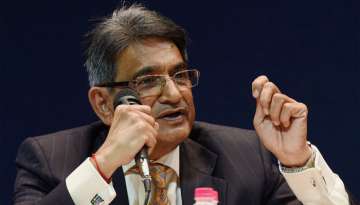New Delhi: The Supreme Court today accepted the major recommendations of Justice R M Lodha panel that suggested some far-reaching structural reforms in the Board of Control for Cricket in India (BCCI).
While the matter has been stretched for over six months, this latest development - the SC agreeing that "no minister or serving bureaucrat can serve on the BCCI board - could usher in much-needed transparency in the functioning of the BCCI.
So far, here are the top 10 developments of the case:
1. The RM Lodha panel was set up by the Supreme Court in January 2015. The task assigned to the panel was to keep a check on the functioning of the BCCI and suggest structural changes to make the cricketing body more transparent.
2. The three-member panel made some recommendations which were released by the apex court on January 4, 2016. Aimed to bring in structural changes, the proposals mainly focussed on age and tenure caps, one-state-one-vote and accountability and distribution of BCCI's funds.
3. The BCCI, taking note of the panel’s suggestions, asked its affiliated units for their views. The one-state-one-vote proposal was objected by the several units as the states of Maharashtra, Gujarat and West Bengal have multiple associations with voting rights.
4. Firm on implementation of the proposals, the Supreme Court, on February 4, 2016, gave a month’s time to the BCCI to make their stance clear. "If you have any difficulty in implementing it (the reforms), we will have the Lodha Committee implement it for you," the bench told the BCCI.
5. About two weeks later on February 19, a BCCI SGM cites difficulties in making the suggested changes. Anurag Thakur, then secretary, was asked to file an affidavit to challenge the report by the Lodha panel.
6. A day before the deadline set by the apex court, the BCCI filed an affidavit on March 2. In the mean time, it executed all other proposals except one-state-one-vote and restriction of commercials during live broadcast of Tests and ODIs. To address the conflict, the board then appointed a CEO, an ombudsman (Justice AP Shah).
7. The SC objected BCCI’s views the very next day, March 3 and stayed adamant on restricting advertisements during live matches.
8. The apex court, on April 2015, slammed the BCCI for distributing unequal funds to its affiliated units.
9. The court continued to slam the board over April and May saying that it is running a prohibitory regime. "You have complete monopoly. If any cricket club or association wants to do anything, we are least bothered. We are not here to reform every cricketing club. But if any institution which is discharging public duty like BCCI, then any organisation or association associated with it will have to reform itself."
10. On May 3, before the summer break, the apex court made it clear that the state units will have to implement the changes suggested by the Lodha panel. "Once the BCCI is reformed it will go down the line and all cricket associations will have to reform themselves if they want to associate with it. The committee constituted in the wake of match-fixing and spot-fixing allegations was a serious exercise and not a futile exercise," the two-judge bench said. On June 30, the SC finally decides to issue an order.
